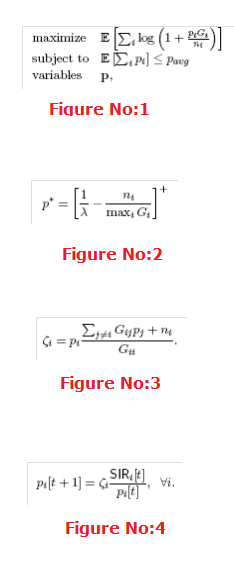Users at maximum priority group acquire to sustain their SIR needs always, however because of the changeable channel situations and mobility of user, in lower priority group the users obtain to distribute the channel and send opportunistically not including violating the SIR user’s needs through higher priority.
The issue of increasing for total users the average throughput is provided as
Figure No:1
While the (Algorithm) probability is approved with reverence to the statistics of channel fading, the gain of direct channel is Gi, Gaussian noise is ni, the budget of average power is the nd Pavg for overall users. The optimal policy to (Algorithm) is as the user by the gain of largest channel is chosen first, i.e., choose User k = argmaxi Gi. Optimal power results provision for User k provided by
Figure No:2
If, λ selected to obtain the constraint of average power. Specified in Algorithm, that can be interpreted geometrically as water-filling more time.
By the models of various channel considered as the scheme of opportunistic power control for throughput increasing in an uplink channel, which is limited interference. The algorithm of power control suggests a transmitter to maximize its power while the channel is best and to reduce its power if the channel is awful, with the proposed metric known as the product of signal-interference and mentioned as:
Figure No:3
Then arrange the transmit power according to the given algorithm.
Algorithm: Opportunistic Power Control.
Figure No:4
The main benefit of the system of power control is that overall users distributable update their power. Moreover, their system is displayed to co-exist through users which it uses the algorithm DPC. Other additionally include cases the constraints of more power is forced and executed soft handoff distributive , and maximization of opportunistic throughput by fairness constraints .
Previous Chapter -> Hybrid Wireless networks
Next Chapter -> In Downlink Opportunistic Utility Maximization
Full Project Report -> Incorporating Energy maps to measure and compare the coherence time and spreading period across mobile wireless networks

